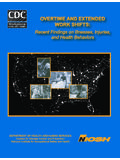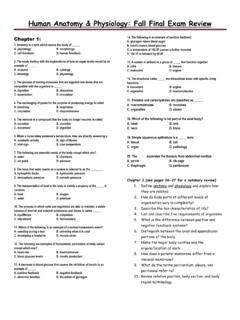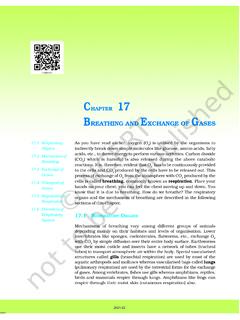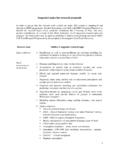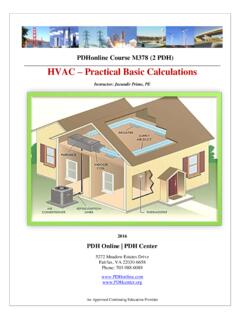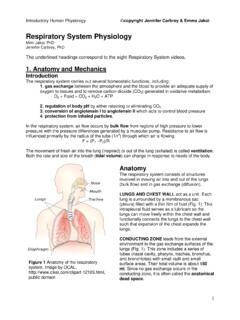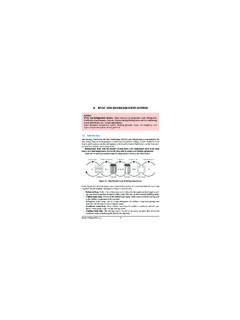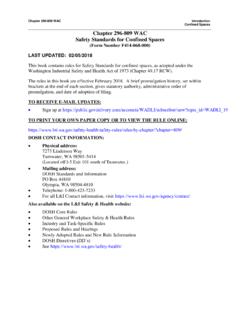Transcription of Introduction to Aviation Physiology
1 FOREWORD Aviation Physiology deals with the physical and mental effects of flight on air crew personnel and passengers. Study of this booklet will familiarize you with some of the physiological problems of flight, and will instruct you in the use of some of the devices that Aviation physiologists and others have developed to assist in human compensation for the numerous environmental changes that are encountered in flight. For most of you, Aviation Physiology is an entirely new field. To others, it is something that you were taught while in military service or elsewhere. This booklet should be used as a reference during your flying career.
2 Remember, every human is physiologically different and can react differently in any given situation. It is our sincere hope that we can enlighten, stimulate, and assist you during your brief stay with us. After you have returned to your regular routine, remember that we at the Civil Aeromedical Institute will be able to assist you with problems concerning Aviation Physiology . Inquiries should be addressed to: Federal Aviation Administration Civil Aerospace Medical Institute Aeromedical Education Division, AAM-400 Mike Monroney Aeronautical Center Box 25082 Oklahoma City, OK 73125 Phone: (405) 954-4837 Fax: (405) 954-8016 i Introduction TO Aviation Physiology human beings have the remarkable ability to adapt to their environment.
3 The human body makes adjustments for changes in external temperature, acclimates to barometric pressure variations from one habitat to another, compensates for motion in space and postural changes in relation to gravity, and performs all of these adjustments while meeting changing energy requirements for varying amounts of physical and mental activity. The human body can adjust to acute and chronic reductions in its oxygen supply by increasing respiratory rate, chemical changes in the blood, and by increasing the production of red blood cells. As efficient as it is, however, a complete absence of oxygen will cause death in approximately five to eight minutes.
4 In Aviation , the demands upon the compensatory mechanisms of the body are numerous and of considerable magnitude. The environmental changes of greatest physiological significance involved in flight are: marked changes in barometric pressure , considerable variation in temperature, and movement at high speed in three dimensions. Advances in Aviation engineering in the past decade have resulted in the development of highly versatile aircraft. Since we are essentially creatures of the ground, we must learn how to adjust to the low pressures and temperatures of flight, and the effects of acceleration on the body . Low visibility, with its associated problems of disorientation and problems related to the general physical and mental stress associated with flight, must be considered.
5 Humans cannot operate these machines at full capacity without physical aids, such as a supplemental supply of oxygen and pressurized cabins for use at altitudes starting as low as 10,000 feet. We must learn to overcome the handicaps imposed by nature on an organism designed for terrestrial life. In particular, the limiting factors in adjustment of the human body to flight must be appreciated. The extent to which these limiting factors are alleviated by available equipment must be clearly understood. Indifference, ignorance, and carelessness can nullify the foresight, ingenuity, and effort involved in supplying the pilot with efficient equipment.
6 The following pages will outline some of the important factors regarding physiological effects of flight, and describe the devices and procedures that will contribute to the safety and efficiency of all who fly. ii Contents Aviation Physiology FOREWORD i Introduction TO Aviation Physiology ii Aviation Physiology QUIZ Q-1 PHYSICS OF THE ATMOSPHERE 1-1 RESPIRATION AND CIRCULATION 2-1 HYPOXIA 3-1 HYPERVENTILATION 4-1 TRAPPED GAS 5-1 ALTITUDE INDUCED DECOMPRESSION SICKNESS 6-1 PRESSURIZATION AND DECOMPRESSION 7-1 OXYGEN EQUIPMENT 8-1 ALTITUDE CHAMBER FLIGHT 9-1 SPATIAL DISORIENTATION 10-1 SELF IMPOSED STRESS 11-1 NOISE AND THE GENERAL Aviation PILOT 12-1 VISION 13-1 PHYSICAL FITNESS 14-1 SURVIVAL 15-1 iii iv Aviation Physiology QUIZ 1.
7 What happens to the atmospheric pressure around your body as you ascend to altitude? _____ 2. What is the percentage of oxygen in the atmosphere at Sea Level ( )?_____ 18K'?_____ 3. If you decompressed from a cabin altitude of 7,000 feet to cruise altitude 35,000 in 30 seconds, what four major physiological problems would you encounter? (1)_____ (2)_____ (3)_____ (4)_____ 4. Define hypoxia and describe the symptoms_____ _____ _____ 5. What is the average effective performance time breathing cabin air at; 18,000 feet?_____ 25,000 feet?_____ 6. Name several factors that may affect your effective performance time (EPT/TUC); _____ _____ 7.
8 Define hyperventilation and describe the symptoms;_____ _____ _____ 8. Name the areas of the body subject to gas expansion during flight; _____ Q-1 Q-2 _____ 9. A pain in the joint caused by evolved gas is known as the _____ and the treatment procedures are;_____ _____ 10. FAR requires the use of supplemental oxygen for crew members in unpressurized aircraft at what altitude?_____ 11. Following SCUBA diving, flying should be delayed _____ hours. 12. FAR states that supplemental oxygen should be used during night flying at/and above what altitude?_____ 13. Pilots' disorientation is commonly called_____ 14.
9 What would you do to combat disorientation?_____ _____ 15. What question regarding Aviation Physiology do you want to ask?_____ _____ _____ PHYSICS OF THE ATMOSPHERE One of the primary problems of flight related to Physiology has to do with the fact that the pressure of gases in the atmosphere change as we ascend and descend. It is essential that we have an understanding of the gases found in the atmosphere and their effects upon the body . Other factors, such as temperature change, also need to be understood so we can protect ourselves from these potential hazards. DEFINITION AND BENEFITS OF THE ATMOSPHERE The atmosphere is a gaseous envelope that covers the earth.
10 The boundary of the atmosphere has been debated for years. While some scientists and physicists set the boundary at 35,000 miles, and a few biologists at 50,000 feet, most scientist, physicists, and meteorologists agree that a more practical boundary is around 1,000 nautical miles. Without the atmosphere there would be no life on earth. The atmosphere provides protection from harmful ultraviolet (UV) rays, cosmic rays, and meteorites. The atmosphere also protects the earth from extreme temperature variations. It supports animal and plant life through its gaseous content and provides rain to grow crops. COMPOSITION OF THE ATMOSPHERE The atmosphere is a mixture of gases.










